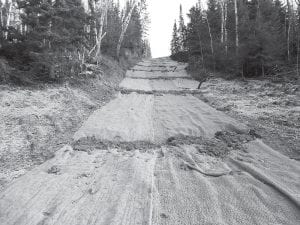Projects completed since the formation of the Poplar River Management Board (PRMB), which represents property owners along the lower Poplar River, are estimated to have reduced sediment in the river by 30-40 percent. The PRMB, formed in 2005 after the river was listed as impaired due to sediment in the water, is working with the Minnesota Pollution Control Agency (MPCA) to use scientific research to figure out the most effective steps to be taken from here. (Above) The most recent project was the Ullr Tightline, which involved installing a pipe to transfer water from a collection pool at the top down a large pipe, where the water’s force is dissipated before emptying into the river.

The Poplar River Management Board (PRMB) has done a lot to reduce sediment in the Poplar River since 2005, when landowners adjacent to the river formed the organization in response to the river being listed as impaired. Where to go from here was a question raised at its bi-monthly meeting at Caribou Highlands on December 14.
The Poplar River has the second-highest water volume of all the rivers on the North Shore. Eliminating all the sediment from the river would be impossible, PRMB President Tom Rider said. Rivers all up and down the North Shore turn Lake Superior brown after big rainstorms. People were surprised when the river was listed as impaired, he said.
“Slowly, we’re going to piece together more of the story,” said Karen Evens of the Minnesota Pollution Control Agency (MPCA) regarding how much of the sediment is natural and how much has been caused by human activity.
Rider said the PRMB was organized to create a public venue to discuss the issue and to raise funds that would help it be proactive in implementing solutions. “We are hoping to be one of the first turbidity-impaired rivers to ever be delisted,” Rider said.
So far, over a million dollars in grants has been awarded to mitigate sediment in the river, with landowners contributing another $600,000. The MCPA has been using this river to learn about causes of and solutions for sediment impairment. “Quite a bit of science has been done,” said Rider, “and it all builds upon itself.”
Research is being done on the effect the ski slopes have on runoff. Rider, co-president of Lutsen Mountains ski resort, said factors include slope length, the type and abundance of living plants and plant debris on the ground, and the hydraulic conductivity of the soil. Water bars built into the slopes have proven to be effective in reducing runoff.
Slumps (areas where soil in the river walls caves into the river), ravines, and ski slopes are three major sources of sediment in the Poplar River, Rider said. Repairing a large slump known as the Megaslump eliminated 75 percent of the river’s slump problem.
Lutsen Mountains has been and is currently implementing numerous measures to reduce sediment runoff, abandoning and re-vegetating about half of their roads, improving storm water practices on the roads that remain, installing storm water collection and dissipation systems on the hillsides, and armoring a large ditch on Ullr Mountain. The resort appointed an erosion control manager, Mark Buckman.
Rider suggested several future priorities such as continuing to refine their mitigation models as the research reveals new information, evaluating the cost/benefit ratios of future slump repairs, and evaluating past projects to find out what helped the most.
MPCA Regional Watershed Supervisor Pat Carey said they estimate that sediment in the river has been reduced by 30-40 percent since the projects began. The MPCA is currently working on developing a new standard for turbidity. Carey said the MPCA is studying rivers all along the North Shore to learn what makes them healthy.
Having the funding and personnel to do the work that needs to be done has been a challenge, said Evens. The MPCA is working on a report on its development of new a standard, called a Total Daily Maximum Load (TMDL). This will include a plan for what needs to get done, who is going to do it, and how progress will be measured.
Dave Zentner of the Duluth Izaak Walton League said he believed the work done has been significant and he appreciated the efforts of the public servants involved in it. Government agencies need to be able to dedicate the resources needed to do the work, he said. He also contended that Cook County allowed practices in riparian areas, such as the construction of impervious surfaces, that caused these problems.
With a new standard and monitoring methods not yet determined, said Kathryn Hoffman of the Minnesota Center for Environmental Advocacy in St. Paul, delisting the river could take a long time. She said she wanted a commitment from the people in the room to get it delisted by a certain date.
At this point, knowing what mitigation measures would be most helpful is difficult, Rider said. Karen Evens reiterated that the MPCA has limited resources to follow through with the findings of the TMDL research.
The next PRMB meeting will be in February.


Leave a Reply